Introduction to TCP/IP
Summary: TCP and IP were developed by a Department of Defense
(DOD) research project to connect a number different networks
designed by different vendors into a network of networks (the
"Internet"). It was initially successful because it delivered a few basic
services that everyone needs (file transfer, electronic mail, remote
logon) across a very large number of client and server systems.
Several computers in a small department can use TCP/IP (along with
other protocols) on a single LAN. The IP component provides routing
from the department to the enterprise network, then to regional
networks, and finally to the global Internet. On the battlefield a
communications network will sustain damage, so the DOD designed
TCP/IP to be robust and automatically recover from any node or
phone line failure. This design allows the construction of very large
networks with less central management. However, because of the
automatic recovery, network problems can go undiagnosed and
uncorrected for long periods of time.
As with all other communications protocol, TCP/IP is composed of
layers:
IP - is responsible for moving packet of data from node to node. IP
forwards each packet based on a four byte destination address (the IP
number). The Internet authorities assign ranges of numbers to
different organizations. The organizations assign groups of their
numbers to departments. IP operates on gateway machines that
move data from department to organization to region and then
around the world.
TCP - is responsible for verifying the correct delivery of data from
client to server. Data can be lost in the intermediate network. TCP
adds support
lost data and to trigger
retransmission until the data is correctly and completely received.
to detect errors or
Sockets - is a name given to the package of subroutines that
provide access to TCP/IP on most systems.
Network of Lowest Bidders
The Army puts out a bid on a computer and DEC wins the bid. The
Air Force puts out a bid and IBM wins. The Navy bid is won by Unisys.
Then the President decides to invade Grenada and the armed forces
discover that their computers cannot talk to each other. The DOD
must build a "network" out of systems each of which, by law, was
delivered by the lowest bidder on a single contract.
�
The Internet Protocol was developed to create a Network of
Networks (the "Internet"). Individual machines are first connected to
a LAN (Ethernet or Token Ring). TCP/IP shares the LAN with other
uses (a Novell file server, Windows for Workgroups peer systems).
One device provides the TCP/IP connection between the LAN and the
rest of the world.
To insure that all
types of systems from all vendors can
communicate, TCP/IP is absolutely standardized on the LAN. However,
larger networks based on long distances and phone lines are more
volatile. In the US, many large corporations would wish to reuse large
internal networks based on IBM's SNA. In Europe, the national phone
companies traditionally standardize on X.25. However, the sudden
explosion of high speed microprocessors, fiber optics, and digital
phone systems has created a burst of new options: ISDN, frame relay,
FDDI, Asynchronous Transfer Mode (ATM). New technologies arise
and become obsolete within a few years. With cable TV and phone
companies competing to build the National Information Superhighway,
no single standard can govern citywide, nationwide, or worldwide
communications.
The original design of TCP/IP as a Network of Networks fits nicely
within the current technological uncertainty. TCP/IP data can be sent
across a LAN, or it can be carried within an internal corporate SNA
network, or it can piggyback on the cable TV service. Furthermore,
machines connected to any of these networks can communicate to
any other network through gateways supplied by the network vendor.
Addresses
Each technology has its own convention for transmitting messages
between two machines within the same network. On a LAN, messages
are sent between machines by supplying the six byte unique identifier
(the "MAC" address). In an SNA network, every machine has Logical
Units with their own network address. DECNET, Appletalk, and Novell
�
IPX all have a scheme for assigning numbers to each local network
and to each workstation attached to the network.
On top of these local or vendor specific network addresses, TCP/IP
assigns a unique number to every workstation in the world. This "IP
number" is a four byte value that, by convention, is expressed by
converting each byte into a decimal number (0 to 255) and separating
the bytes with a period. For example, the PC Lube and Tune server is
130.132.59.234.
begins
sending
organization
electronic mail
to
Hostmaster@INTERNIC.NET requesting assignment of a network
number. It is still possible for almost anyone to get assignment of a
number for a small "Class C" network in which the first three bytes
identify the network and the last byte identifies the individual
computer. The author followed this procedure and was assigned the
numbers 192.35.91.* for a network of computers at his house. Larger
organizations can get a "Class B" network where the first two bytes
identify the network and the last two bytes identify each of up to 64
thousand individual workstations. Yale's Class B network is 130.132,
so all computers with IP address 130.132.*.* are connected through
Yale.
An
by
The organization then connects to the Internet through one of a
dozen regional or specialized network suppliers. The network vendor
is given the subscriber network number and adds it to the routing
configuration in its own machines and those of the other major
network suppliers.
There is no mathematical formula that translates the numbers
192.35.91 or 130.132 into "Yale University" or "New Haven, CT." The
machines that manage large regional networks or the central Internet
routers managed by the National Science Foundation can only locate
these networks by looking each network number up in a table. There
are potentially thousands of Class B networks, and millions of Class C
networks, but computer memory costs are low, so the tables are
reasonable. Customers that connect to the Internet, even customers
as large as IBM, do not need to maintain any information on other
networks. They send all external data to the regional carrier to which
they subscribe, and the regional carrier maintains the tables and does
the appropriate routing.
New Haven is in a border state, split 50-50 between the Yankees
and the Red Sox. In this spirit, Yale recently switched its connection
from the Middle Atlantic regional network to the New England carrier.
When the switch occurred, tables in the other regional areas and in
the national spine had to be updated, so that traffic for 130.132 was
routed through Boston instead of New Jersey. The large network
carriers handle the paperwork and can perform such a switch given
�
sufficient notice. During a conversion period, the university was
connected to both networks so that messages could arrive through
either path.
Subnets
Although the individual subscribers do not need to tabulate
network numbers or provide explicit routing, it is convenient for most
Class B networks to be internally managed as a much smaller and
simpler version of the larger network organizations. It is common to
subdivide the two bytes available for internal assignment into a one
byte department number and a one byte workstation ID.
The enterprise network is built using commercially available
TCP/IP router boxes. Each router has small tables with 255 entries to
translate the one byte department number into selection of a
destination Ethernet connected to one of the routers. Messages to the
PC Lube and Tune server (130.132.59.234) are sent through the
national and New England regional networks based on the 130.132
part of the number. Arriving at Yale, the 59 department ID selects an
Ethernet connector in the C& IS building. The 234 selects a particular
workstation on that LAN. The Yale network must be updated as new
Ethernets and departments are added, but it is not effected by
changes outside the university or the movement of machines within
the department.
A Uncertain Path
Every time a message arrives at an IP router, it makes an
individual decision about where to send it next. There is concept of a
session with a preselected path for all traffic. Consider a company with
facilities in New York, Los Angeles, Chicago and Atlanta. It could build
a network from four phone lines forming a loop (NY to Chicago to LA
to Atlanta to NY). A message arriving at the NY router could go to LA
via either Chicago or Atlanta. The reply could come back the other
�
way.
How does the router make a decision between routes? There is no
correct answer. Traffic could be routed by the "clockwise" algorithm
(go NY to Atlanta, LA to Chicago). The routers could alternate,
sending one message to Atlanta and the next to Chicago. More
sophisticated routing measures traffic patterns and sends data
through the least busy link.
If one phone line in this network breaks down, traffic can still
reach its destination through a roundabout path. After losing the NY to
Chicago line, data can be sent NY to Atlanta to LA to Chicago. This
provides continued service though with degraded performance. This
kind of recovery is the primary design feature of IP. The loss of the line
is immediately detected by the routers in NY and Chicago, but
somehow this information must be sent to the other nodes. Otherwise,
LA could continue to send NY messages through Chicago, where they
arrive at a "dead end." Each network adopts some Router Protocol
which periodically updates the routing tables throughout the network
with information about changes in route status.
If the size of the network grows, then the complexity of the routing
updates will increase as will the cost of transmitting them. Building a
single network that covers the entire US would be unreasonably
complicated. Fortunately, the Internet is designed as a Network of
Networks. This means that loops and redundancy are built into each
regional carrier. The regional network handles its own problems and
reroutes messages internally. Its Router Protocol updates the tables in
its own routers, but no routing updates need to propagate from a
regional carrier to the NSF spine or to the other regions (unless, of
course, a subscriber switches permanently from one region to
another).
Undiagnosed Problems
IBM designs its SNA networks to be centrally managed. If any
error occurs, it is reported to the network authorities. By design, any
error is a problem that should be corrected or repaired. IP networks,
however, were designed to be robust. In battlefield conditions, the
loss of a node or line is a normal circumstance. Casualties can be
sorted out later on, but the network must stay up. So IP networks are
robust. They automatically (and silently) reconfigure themselves
when something goes wrong. If there is enough redundancy built into
the system, then communication is maintained.
In 1975 when SNA was designed, such redundancy would be
prohibitively expensive, or it might have been argued that only the
Defense Department could afford it. Today, however, simple routers
cost no more than a PC. However, the TCP/IP design that, "Errors are
normal and can be largely ignored," produces problems of its own.
�
Data traffic is frequently organized around "hubs," much like
airline traffic. One could imagine an IP router in Atlanta routing
messages for smaller cities throughout the Southeast. The problem is
that data arrives without a reservation. Airline companies experience
the problem around major events, like the Super Bowl. Just before the
game, everyone wants to fly into the city. After the game, everyone
wants to fly out. Imbalance occurs on the network when something
new gets advertised. Adam Curry announced the server at "mtv.com"
and his regional carrier was swamped with traffic the next day. The
problem is that messages come in from the entire world over high
speed lines, but they go out to mtv.com over what was then a slow
speed phone line.
Occasionally a snow storm cancels flights and airports fill up with
stranded passengers. Many go off to hotels in town. When data
arrives at a congested router, there is no place to send the overflow.
Excess packets are simply discarded. It becomes the responsibility of
the sender to retry the data a few seconds later and to persist until it
finally gets through. This recovery is provided by the TCP component
of the Internet protocol.
Each large company or university that subscribes to the Internet
TCP was designed to recover from node or line failures where the
network propagates routing table changes to all router nodes. Since
the update takes some time, TCP is slow to initiate recovery. The TCP
algorithms are not tuned to optimally handle packet loss due to traffic
congestion. Instead, the traditional Internet response to traffic
problems has been to increase the speed of lines and equipment in
order to say ahead of growth in demand.
TCP treats the data as a stream of bytes. It logically assigns a
sequence number to each byte. The TCP packet has a header that
says, in effect, "This packet starts with byte 379642 and contains 200
bytes of data." The receiver can detect missing or incorrectly
sequenced packets. TCP acknowledges data that has been received
and retransmits data that has been lost. The TCP design means that
error recovery is done end-to-end between the Client and Server
machine. There is no formal standard for tracking problems in the
middle of the network, though each network has adopted some ad hoc
tools.
Need to Know
There are three levels of TCP/IP knowledge. Those who administer
a regional or national network must design a system of long distance
phone lines, dedicated routing devices, and very large configuration
files. They must know the IP numbers and physical
locations of
thousands of subscriber networks. They must also have a formal
network monitor strategy to detect problems and respond quickly.
�
must have an intermediate level of network organization and
expertise. A half dozen routers might be configured to connect several
dozen departmental LANs in several buildings. All traffic outside the
organization would typically be routed to a single connection to a
regional network provider.
However, the end user can install TCP/IP on a personal computer
without any knowledge of either the corporate or regional network.
Three pieces of information are required:
1.The IP address assigned to this personal computer
The part of the IP address (the subnet mask) that distinguishes other
machines on the same LAN (messages can be sent to them directly)
from machines in other departments or elsewhere in the world (which
are sent to a router machine)
2.The IP address of the router machine that connects this LAN to
the rest of the world.
3.In the case of the PCLT server, the IP address is 130.132.59.234.
Since the first three bytes designate this department, a "subnet
mask" is defined as 255.255.255.0 (255 is the largest byte value and
represents the number with all bits turned on). It is a Yale convention
(which we recommend to everyone) that
the router for each
department have station number 1 within the department network.
Thus the PCLT router is 130.132.59.1. Thus the PCLT server is
configured with the values:
My IP address: 130.132.59.234
Subnet mask: 255.255.255.0
Default router: 130.132.59.1
The subnet mask tells the server that any other machine with an
IP address beginning 130.132.59.* is on the same department LAN,
so messages are sent to it directly. Any IP address beginning with a
different value is accessed indirectly by sending the message through
the router at 130.132.59.1 (which is on the departmental LAN).
Additional information is available in self-study courses from SRA
(1-800-SRA-1277)
TCP/IP [34610]
Copyright 1995 PCLT -- Introduction to TCP/IP -- H. Gilbert
�
TCP/IP 的介绍说明
摘要:TCP/IP 是由美国国防部(DOD)开发的一个研究项目,用以将不同的网络
厂商设计的不同网络连接到由许多网络组成的一个网络中(即“互联网”)。它
取得了初步的成功,因为它通过穿越大量的客户机与服务器系统向人们提供了一
些基本的需求服务(如文件传输的基本服务,电子邮件,远程登录)。在一个单
一局域网中一个小部门多台计算机可以使用 TCP / IP(同其他协议)。IP 组件提
供的路由可以从部门到企业网络,然后再到区域网络,并最终接入全球互联网。
在战场上,通信网络将面临被破坏的危险,因此,美国国防部设计的 TCP / IP
要很健全稳定,并能从任何节点或电话线路故障中自动恢复。这样的设计允许在
较少的中央控制下组建庞大的网络。此外,由于自动恢复机制,网络问题可以在
很长一段时间内不被进行问题诊断和错误纠正。
正如其他所有通信协议,TCP / IP 协议是由多个层组成的:
•IP - 负责将数据包从一个节点移动到另一个节点。每个数据包的 IP 转发
基于四字节的目的地址(IP 地址)。互联网管理机构对不同地区组织分配了一定
数量的 IP 地址。各地区组织将他们所拥有的地址划分成数个组再分配到各个部
门。IP 运行在被称为网关的机器上面,而网关的作用是将数据包层层转发,从
部门到组织再到地区最后送达全世界。
•TCP - 负责核查从客户传送到服务器的数据正确性。数据在传递时可能会
在中间的网络发生丢失。TCP 增加了对错误以及丢失数据的检测并且能在发生问
题时激活数据重传机制直到数据被正确和完整的接收。
•Sockets – 是一个数据包子程序的名称,该子程序能提供在大多数系统上
接入 TCP/IP 的功能。
网络的最低投标
美国陆军提出了一个计算机上系统上的竞标由 DEC 公司赢得。美国空军也提
出一个竞标并由 IBM 公司赢得。而美国海军的竞标则由 Unisys 公司赢得。当美
国总统决定入侵格林纳达时,美国军方发现他们的陆海空三军各自所拥有的计算
机不能与其他军种的计算机相互通信。因此,美国国防部必须建立一个网络体系,
它不依赖于陆海空三军各自根据法律法规由最低竞价者按照合同所交付的计算
机系统。
�
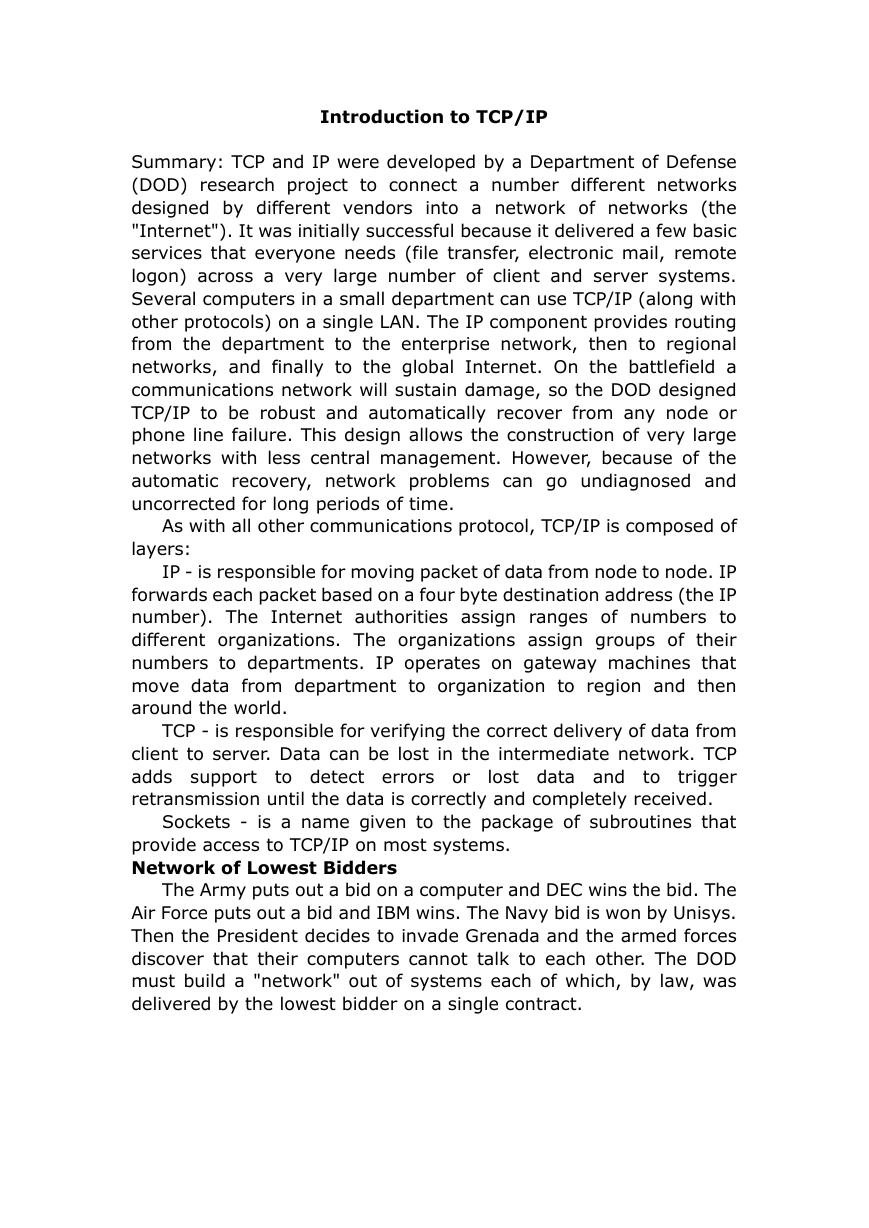
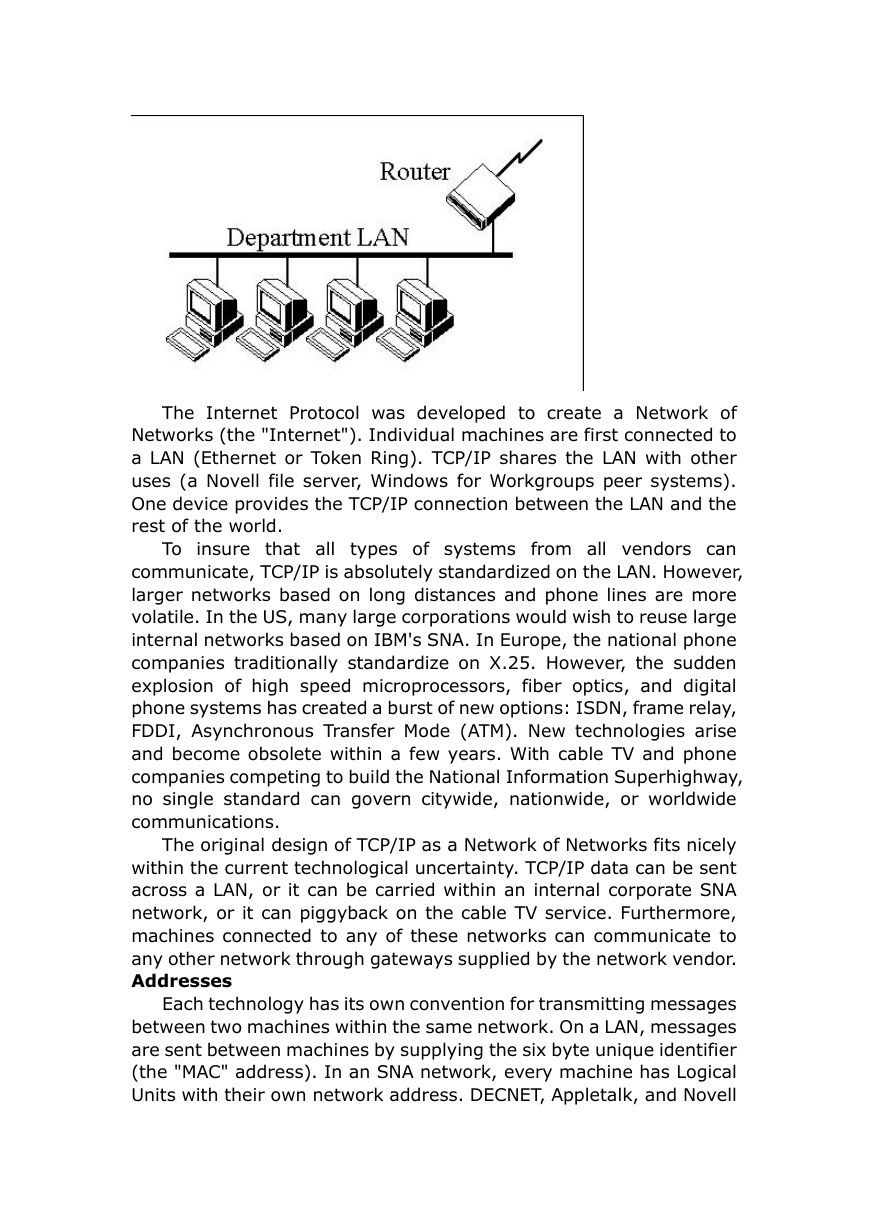
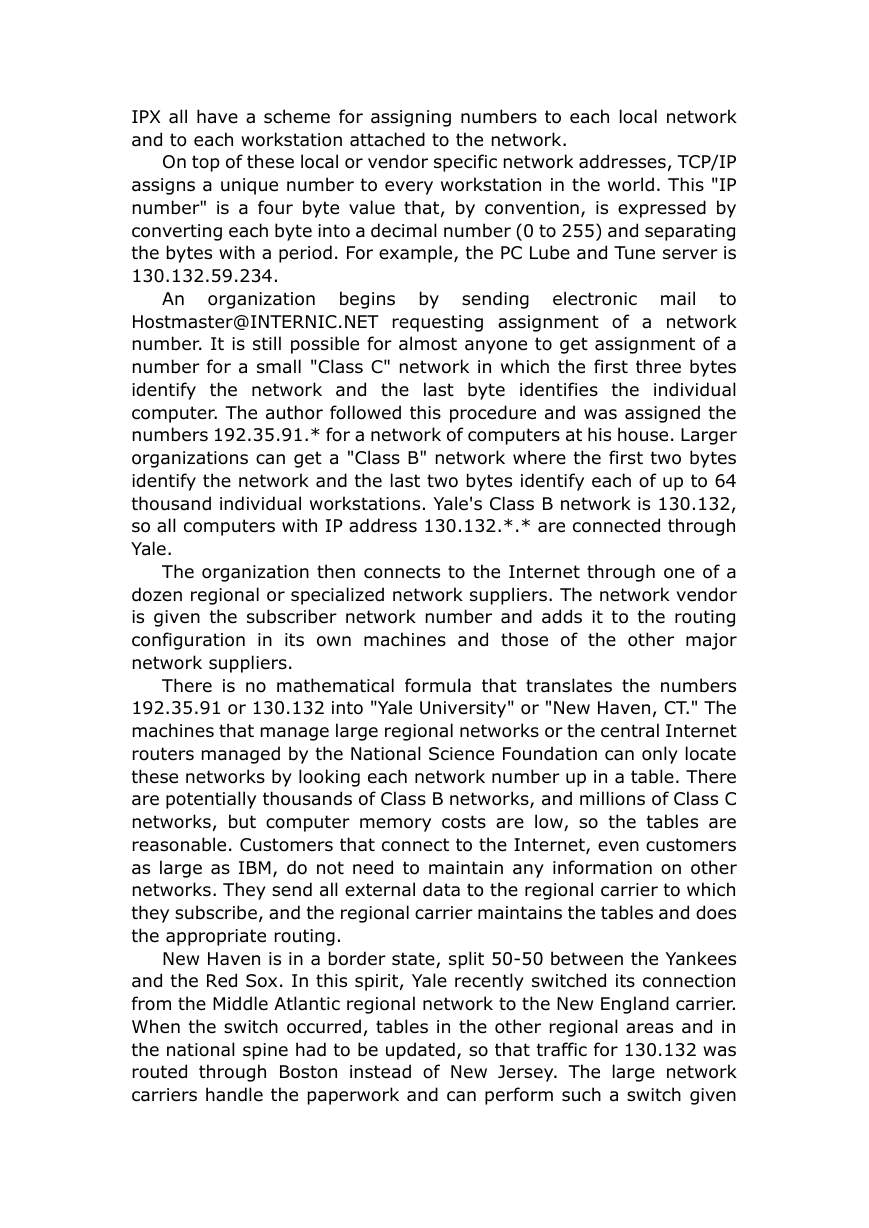


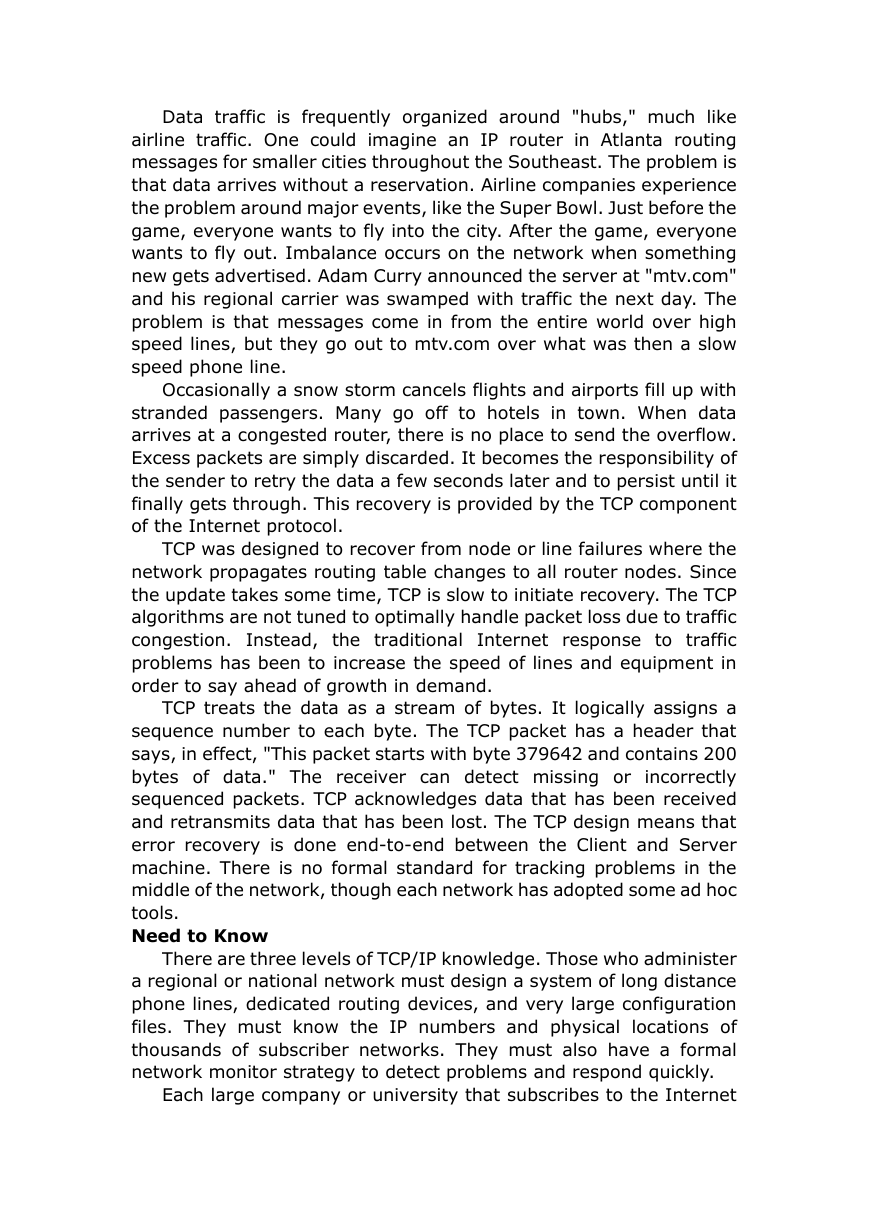
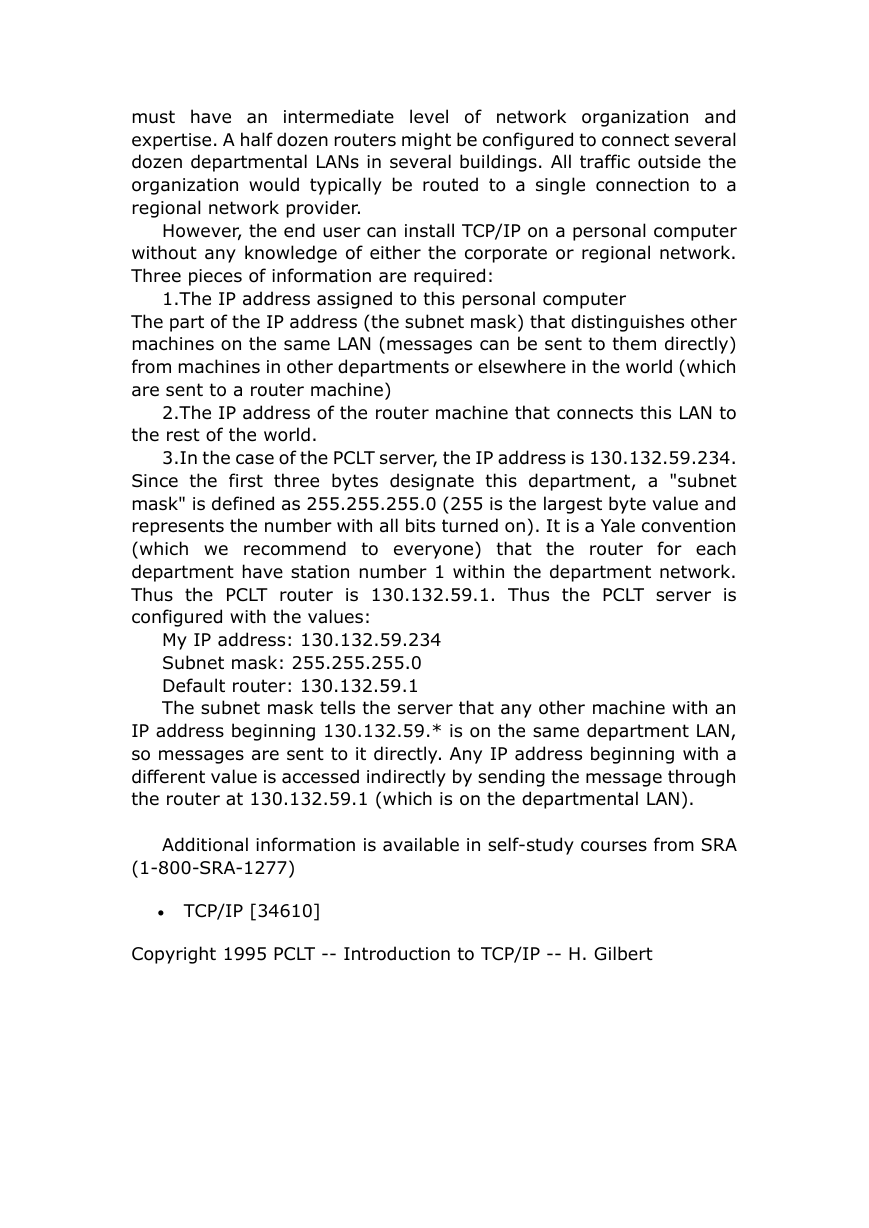
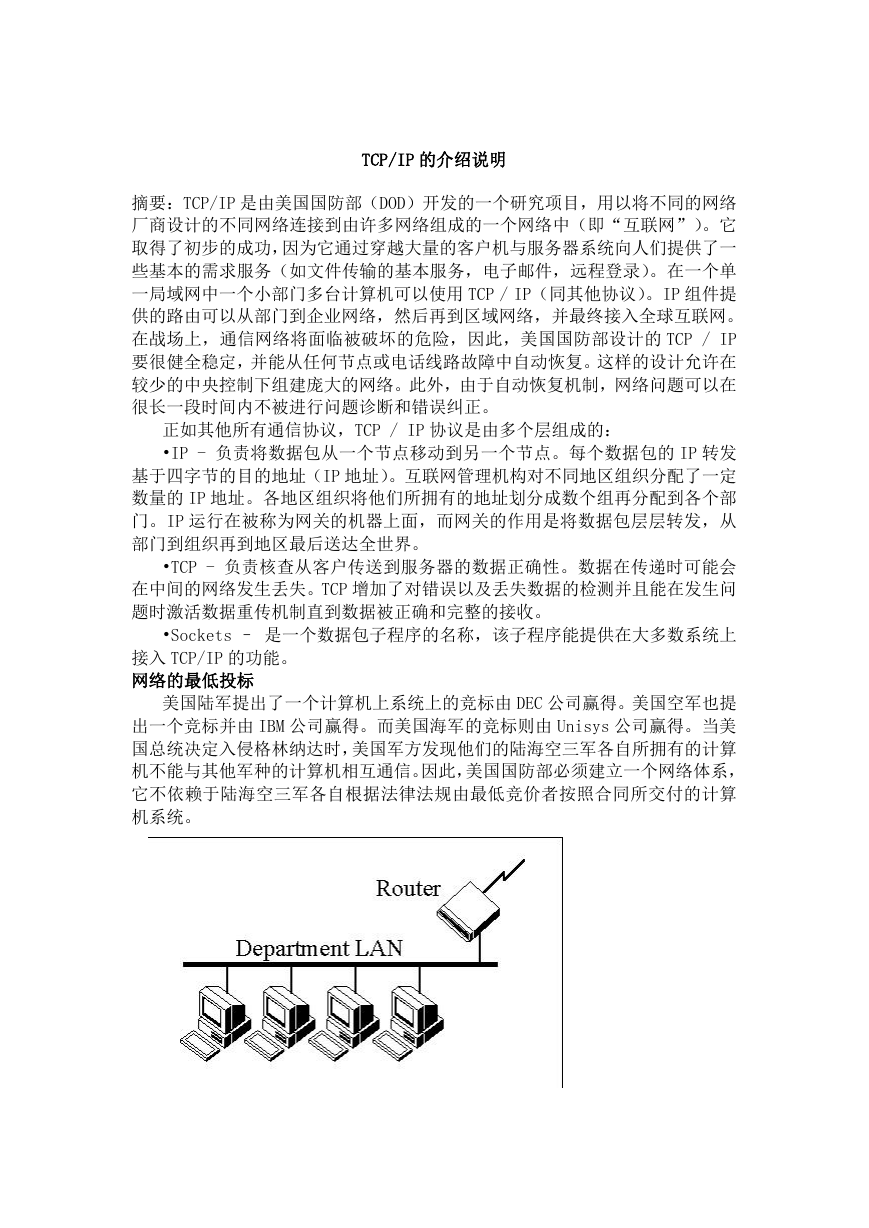








 2023年江西萍乡中考道德与法治真题及答案.doc
2023年江西萍乡中考道德与法治真题及答案.doc 2012年重庆南川中考生物真题及答案.doc
2012年重庆南川中考生物真题及答案.doc 2013年江西师范大学地理学综合及文艺理论基础考研真题.doc
2013年江西师范大学地理学综合及文艺理论基础考研真题.doc 2020年四川甘孜小升初语文真题及答案I卷.doc
2020年四川甘孜小升初语文真题及答案I卷.doc 2020年注册岩土工程师专业基础考试真题及答案.doc
2020年注册岩土工程师专业基础考试真题及答案.doc 2023-2024学年福建省厦门市九年级上学期数学月考试题及答案.doc
2023-2024学年福建省厦门市九年级上学期数学月考试题及答案.doc 2021-2022学年辽宁省沈阳市大东区九年级上学期语文期末试题及答案.doc
2021-2022学年辽宁省沈阳市大东区九年级上学期语文期末试题及答案.doc 2022-2023学年北京东城区初三第一学期物理期末试卷及答案.doc
2022-2023学年北京东城区初三第一学期物理期末试卷及答案.doc 2018上半年江西教师资格初中地理学科知识与教学能力真题及答案.doc
2018上半年江西教师资格初中地理学科知识与教学能力真题及答案.doc 2012年河北国家公务员申论考试真题及答案-省级.doc
2012年河北国家公务员申论考试真题及答案-省级.doc 2020-2021学年江苏省扬州市江都区邵樊片九年级上学期数学第一次质量检测试题及答案.doc
2020-2021学年江苏省扬州市江都区邵樊片九年级上学期数学第一次质量检测试题及答案.doc 2022下半年黑龙江教师资格证中学综合素质真题及答案.doc
2022下半年黑龙江教师资格证中学综合素质真题及答案.doc